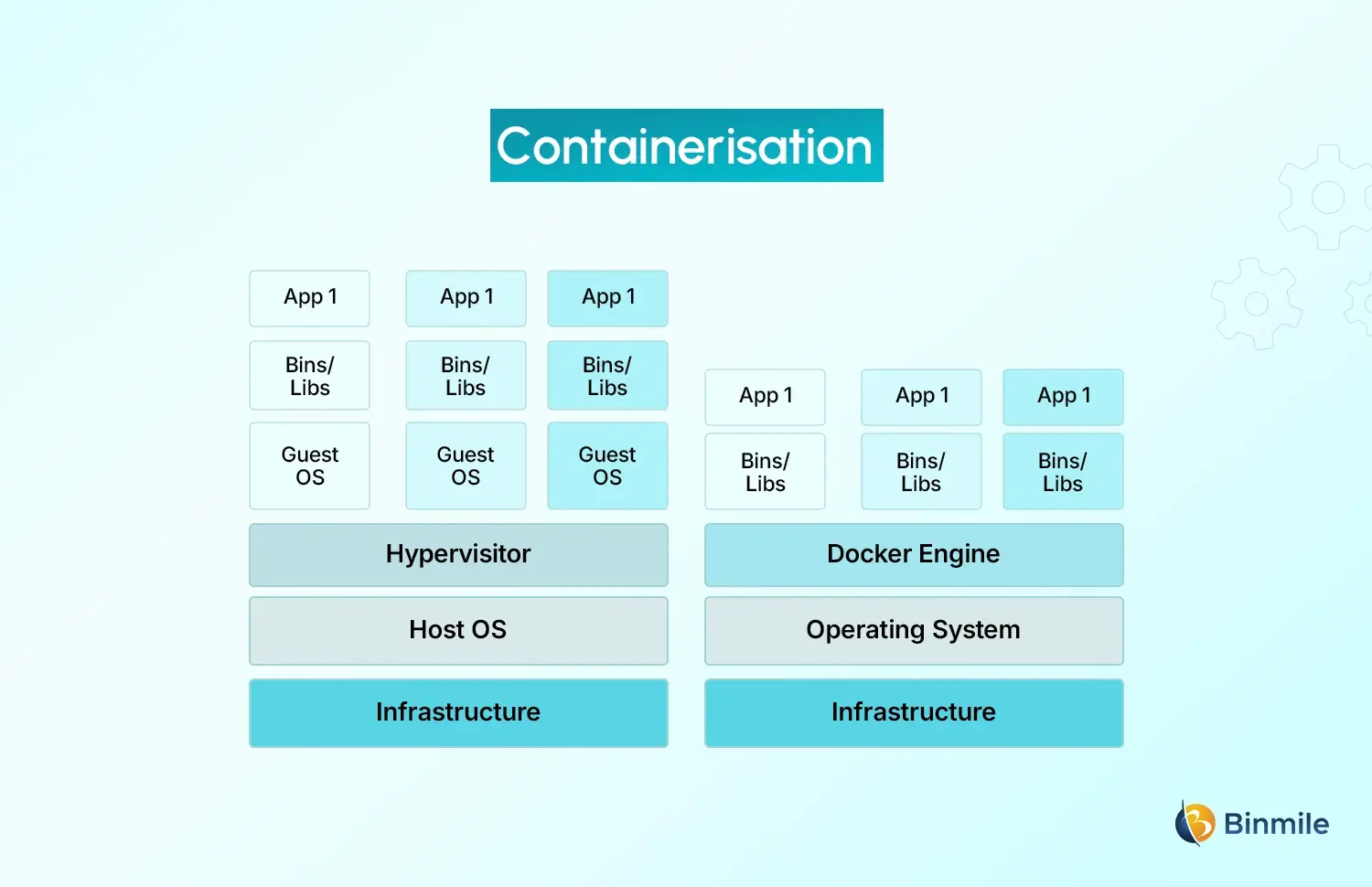The way businesses build, deploy, and manage software is undergoing a major transformation. According to Grand View Research, the global application virtualisation market was valued at USD 3.43 billion in 2023, with forecasts pointing to a rise to USD 8.40 billion by 2030, growing at a compound annual growth rate (CAGR) of 14.3% from 2024 to 2030. This surge reflects how organisations are turning to virtualisation technologies to support increasingly distributed and dynamic work environments.
There are two popular technologies in this domain, virtualisation and containerisation. Each method has its own unique benefits, drawbacks, and applications, but knowing how they differ is crucial in making the optimal choice for your infrastructure.
This blog will define what virtualisation and containerisation are and explain containerisation vs virtualisation using examples and tables. Also discussed will be microservices architectures, containerisation in DevOps, and the virtualisation component in cloud computing. At the end, you will be able to identify the technology that best fits your business needs and how DevOps consulting, cloud consulting, and legacy application modernisation will best prepare you to take the appropriate steps.
What is Virtualisation?

Virtualisation (or virtualisation technology) refers to creating a virtual version of computing resources such as hardware platforms, storage devices, networks, or even entire operating systems. Put simply, a physical server (host) can be split into several virtual servers (virtual machines or VMs), each running its own guest operating system and applications. A hypervisor, a piece of software, manages and allocates resources to VMs while being situated between the hardware and the VMs.
Virtualisation is commonplace in cloud computing: a cloud service provider, for example, uses virtualisation to create and manage multiple isolated environments and instances on a single physical server. When you consider virtualisation in cloud computing, think of advanced infrastructure that can run different operating systems and isolate workloads, letting legacy applications and diverse programs run in parallel.
What is Containerisation?

Containerisation refers to operating-system-level (or application-level) virtualisation, where applications and their dependencies are packaged into containers that run on a shared OS kernel. Tools such as Docker exemplify this technology. Docker provides a consistent and isolated operating environment for a specific application as well as its libraries, dependencies, or configurations.
Containerisation is ideal for supporting microservices architectures, where large applications are designed as a suite of smaller independent services. Containers are ideal for that because they are lightweight and portable. When you hear Containerisation, cloud, or Containerisation in DevOps, the idea is that containers make development, deployment, scaling, and operations smoother, especially for modern apps.
Containerisation vs Virtualisation: Key Differences
Here is a comparison of Containerisation and virtualisation differences to help clarify.
Real-World Use Cases of Virtualisation & Containerisation
Let us explore some real-world scenarios of how businesses are leveraging both approaches.
Virtualisation Use Cases
- A large enterprise keeps some of its legacy applications, which require older versions of specific operating systems. They create separate VMs for each application. Each virtual machine is encapsulated, contained, and managed via a virtualisation platform.
- A cloud provider that offers an infrastructure-as-a-service (IaaS) solution is a cloud provider that is a consumer of virtualisation technology. He runs his virtualisation technology on several of his cloud tenants, consolidating multiple customers’ workloads on a single physical server.
- Running several operating systems in parallel on one physical host, for example, Windows and Linux.
Containerisation Use Cases
- A startup switching to a microservices architecture develops its monolithic application. Each microservice is encapsulated in its own container, which is stored in a container registry and allows for rapid deployment and scaling of the microservice.
- DevOps teams onboard new developers using a Docker Guide for Beginners, which allows them to quickly push containers in CI/CD and consistently deploy to staging and production environments.
- A cloud-native application that runs in a multi-cloud environment uses Containerization for cross-cloud portability over AWS, Azure, and GCP.
- Containerisation allows an application to be wrapped up, migrated to a container-orchestrated cluster, and used to reduce the infrastructure’s footprint.
Combined Approach
Often, organisations use both: VMs form the base infrastructure, and containers run inside those VMs. That is the only difference between containers and virtual machines. For example, you might run a VM for each environment (dev, test, prod), and within each VM, you run containerised services. This is common in legacy application modernisation, where older apps run in VMs and new microservices run in containers.
Whether you’re exploring virtualisation for stability or containerization for speed, we help you design a balanced, future-proof architecture.

Benefits and Challenges of Virtualisation and Containerisation
Here is the table covering the benefits and challenges of each.
| Technology | Benefits | Challenges |
|---|---|---|
| Virtualisation | Strong isolation; supports different OSes; mature toolsets. | Higher overhead, slower startup, and less efficient resource usage. |
| Containerisation | Faster deployment; efficient resource use; ideal for microservices and cloud-native. | Shared kernel can be risky; requires newer operational practices; sometimes less mature tooling for very old apps. |
Some highlights:
Containers are very good when you adopt microservices architectures: they allow independent scaling, deployment, and versioning. However, virtualisation shines for legacy application modernisation when you have monolithic apps or OS dependencies. In cloud consulting scenarios, when advising clients about Containerisation in DevOps versus virtualisation in cloud computing, the consultant must weigh both benefits and challenges.
For example, a company shifting to DevOps might ask: Should we move all our workloads into containers, or keep some of them in VMs? The answer depends on workload type, team maturity, and performance/security requirements.
Choosing the Right Approach for Your Business
How should you decide whether to use Containerisation or virtualisation? Here are some guiding questions and considerations:
1. What is your application type?
- Fast deployment, automatic scaling, and regular updates? Containerisation is certainly the best option. It works unbelievably well with microservices-based applications.
- Do you have a monolithic application or a legacy application that depends on a particular OS or kernel? Requires some strong isolation? In that case, you should probably use virtualisation.
2. What are your team’s capabilities and culture?
- Do you have the Ops and Dev teams executing the DevOps workflows? Have they set up containers, CI/CD, and orchestration tools? In that case, the enhanced operational efficiencies that Containerisation provides are a fit.
- If your team is more acquainted with traditional IT infrastructure, managing VMs, and OS patching, then virtualisation will be more reliable in the short term.
3. What is your infrastructure environment?
- With multi-cloud or hybrid cloud scenarios, if portability is important, you will want Containerization.
- If you have workloads that have strict security or isolation requirements (e.g., running different OSes side by side), then you will need virtualisation.
4. What are your resource and cost constraints?
- With containers, you can maximise density and minimise waste since numerous containers can utilise the same operating system kernel.
- If your concern is having spare capacity and overhead costs are manageable, then the use of virtual machines is probably appropriate if you are prioritising strong isolation.
5. Strategic considerations
- You will likely need both options: some workloads will remain in VMs, while you will build new applications in containerised and microservices architectures. This hybrid method integrates well with cloud consulting and modernising legacy applications.
- When scaling, containers are typically a better choice because of faster spin-up times, easier orchestration with tools like Kubernetes, and support of the dev-ops model, which also enhances modern application architectures.
Summary Decision:
For agility, speed, portability, efficient scaling, and modern architectures based on microservices, go with Containerisation. For strong OS isolation and support for several/different OS versions, or legacy systems, go with virtualisation. And frequently, the best route forward is a mix of both systems, especially for organisations in transition.
Build reliable, scalable, and cloud-ready solutions with our custom software development services and DevOps expertise.

Conclusion
In the debate of Containerisation vs Virtualisation, neither technology is inherently better in all cases. However, the right answer depends on your business goals, application types, operational maturity, and infrastructure needs.
If your organisation is transforming into a DevOps culture and moving toward cloud-native applications and microservices architectures, then investing in Containerisation (and associated Containerisation services, Containerisation in DevOps, and Containerisation cloud) makes sense. On the other hand, if you are dealing with a broad mix of legacy applications, different OSes, or strong isolation/security requirements, virtualisation remains a strong foundation.
For businesses seeking support, businesses like Binmile provide services, like DevOps consulting services and cloud consulting services, which can help evaluate your environment and chart a path forward. Whether you decide to adopt Containerisation, virtualisation, or a blend of both, the goal is the same: deliver applications faster, scale smarter, and use infrastructure more efficiently.
Frequently Asked Questions
Not exactly. Containerisation is a technology/approach that enables you to package applications and their dependencies into containers. A microservice is an architectural style where an application is composed of many small, independent services. Containers are often used to implement microservices architectures because they provide a convenient, isolated, consistent runtime for each service.
A virtual machine (VM) simulates a full computer system: it runs its own guest operating system and applications, even though it uses physical server resources. The purpose is to maximise resource utilisation by running multiple separate OS environments on a single physical host, enabling isolation, consolidation, and flexibility.
Generally speaking, virtual machines offer stronger isolation because each VM has its own OS kernel, and there is a hypervisor boundary. Containers share the host OS kernel and, therefore, can be more vulnerable if the kernel is compromised. That said, container security has improved significantly, and many organisations use containers securely. The right security posture depends on how the isolation is configured, how images are managed, and the level of operational maturity.
For Containerisation: Docker, Containerd, Kubernetes (for orchestration), Podman.
For virtualisation: VMware vSphere, Microsoft Hyper-V, KVM, Xen.
You will also find lots of cloud-specific services for both.
Both technologies will continue to evolve and often co-exist. Containerisation is increasingly central to modern application development, microservices architectures, DevOps workflows, and cloud-native deployments.
Virtualisation remains foundational for general infrastructure, legacy apps, and strong OS isolation. There is also convergence: hypervisor/container hybrid models, better orchestration, deeper security models, and more cloud integration. Choosing the right mix will be a key strategic differentiator.









